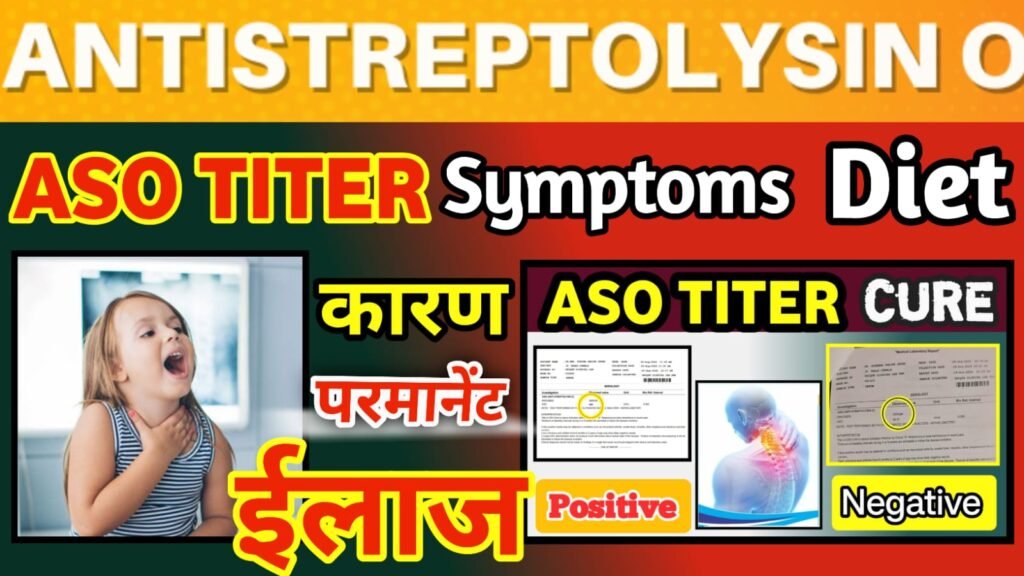Introduction to ASO Titer
The Antistreptolysin O (ASO) titer is a blood test used to detect antibodies against streptolysin O, a toxin produced by Group A Streptococcus bacteria. This diagnostic tool holds significant importance in the medical field, particularly in identifying past infections caused by these bacteria. When the body encounters the streptolysin O toxin, it produces antibodies to neutralize its effects. The ASO titer measures the concentration of these antibodies in the bloodstream, enabling healthcare providers to assess whether a patient has experienced a recent streptococcal infection.
ASO titer testing is particularly relevant in diagnosing conditions such as rheumatic fever and post-streptococcal glomerulonephritis. Rheumatic fever is an inflammatory disease that can develop after an inadequately treated streptococcal throat infection. It may lead to complications like heart valve damage if not promptly addressed. Similarly, post-streptococcal glomerulonephritis is a kidney disorder that occurs after a streptococcal infection, resulting in inflammation of the renal glomeruli. By measuring the levels of ASO antibodies, clinicians can confirm whether these conditions are linked to a prior streptococcal infection.
Understanding the ASO titer’s role in medical diagnostics helps elucidate its utility in monitoring infections and guiding treatment plans. Elevated ASO levels indicate an immune response to a streptococcal infection, which can be critical in making accurate diagnoses and determining appropriate therapeutic interventions. The test is not typically used to diagnose an active infection but rather to provide evidence of a recent one, aiding in the evaluation of symptoms that may be related to post-infectious complications.
In summary, the ASO titer is a cornerstone in the diagnostic process for conditions associated with Group A Streptococcus bacteria. Its ability to measure antibody levels against streptolysin O provides invaluable insights into the body’s immunological history, informing the management of related diseases and ensuring timely and effective medical care.
The Role of ASO Titer in Conventional Medicine
Antistreptolysin O (ASO) titer is a blood test that measures the levels of antibodies produced in response to a streptococcal infection. In modern conventional medicine, the ASO titer holds significant importance in diagnosing and managing streptococcal infections, particularly those caused by Group A Streptococcus (GAS). The standard procedure for ASO titer testing involves drawing a blood sample from the patient, which is then analyzed in a laboratory to determine the concentration of ASO antibodies.
The interpretation of ASO titer results requires a nuanced understanding of the patient’s clinical history and symptoms. Elevated ASO titers typically indicate a recent streptococcal infection, as these antibodies tend to peak a few weeks post-infection. However, it is crucial to consider that not all individuals with a streptococcal infection will exhibit a high ASO titer, and some may have an elevated titer due to past infections. Therefore, clinicians often rely on a combination of ASO titer results and other diagnostic tools to confirm a streptococcal infection.
In clinical settings, ASO titer results play a pivotal role in guiding treatment plans. For instance, in cases of rheumatic fever or post-streptococcal glomerulonephritis, elevated ASO titers can corroborate the diagnosis and justify the initiation of appropriate antibiotic therapy. Treatment strategies may include penicillin or other antibiotics to eradicate the streptococcal bacteria, alongside anti-inflammatory medications to manage symptoms.
Case studies highlight the practical relevance of ASO titer testing. For example, a patient presenting with arthritis and carditis may undergo ASO titer testing to confirm a diagnosis of rheumatic fever. An elevated ASO titer, combined with clinical findings and other laboratory tests, can lead to a timely diagnosis, enabling the healthcare provider to commence treatment promptly and mitigate potential complications.
Overall, the ASO titer is a valuable diagnostic tool in conventional medicine, offering insights into the body’s response to streptococcal infections and assisting in the formulation of effective treatment plans. Its application in clinical practice underscores the necessity of accurate and timely diagnosis for the management of streptococcal-related diseases.

Here are 10 key points regarding ASO (Anti-Streptolysin O) titer treatment using Ayurveda:
- Holistic Approach: Ayurveda treats the individual as a whole, addressing both physical and mental health to manage ASO levels.
- Herbal Remedies: Herbs like Tulsi and Ashwagandha are known for their anti-inflammatory and immune-boosting properties, which may help reduce ASO titers.
- Detoxification: Ayurvedic treatments often involve detoxification processes to remove toxins that may contribute to elevated ASO levels.
- Dietary Recommendations: A balanced diet rich in fruits, vegetables, and whole grains is emphasized to strengthen the immune system and promote recovery.
- Panchakarma Therapy: This Ayurvedic detoxification therapy helps cleanse the body and restore balance, potentially lowering ASO titers.
- Stress Management: Techniques like yoga and meditation are used to manage stress, which can influence overall health and immune response.
- Customized Treatments: Ayurveda tailors treatments based on individual constitution (dosha) and specific health conditions.
- Anti-inflammatory Agents: Ayurvedic herbs like Turmeric (curcumin) have strong anti-inflammatory properties that can help alleviate symptoms related to high ASO.
- Supporting Digestion: Improved digestion through herbal tonics and a suitable diet is crucial for enhancing overall health and immunity.
- Ongoing Monitoring: Regular consultation with a qualified Ayurvedic practitioner ensures the treatment remains effective and adapted to changing health needs.
For further details on ASO titer treatment and Ayurvedic practices, you can refer to reputable health resources or consult an Ayurvedic practitioner for personalized advice.
Introduction to Herbal Medicine
Herbal medicine, often referred to as phytotherapy, is a practice that dates back thousands of years, encompassing a rich history of using plants and natural substances for healing and maintaining health. Rooted in ancient traditions, herbal medicine spans various cultures and civilizations, each contributing to the vast knowledge and principles that define this field. The fundamental premise of herbal medicine lies in the belief that plants harbor compounds with potent therapeutic properties capable of addressing a wide range of health conditions.
The principles of herbal medicine are deeply intertwined with the holistic approach, which emphasizes treating the individual as a whole rather than merely focusing on specific symptoms. This holistic perspective considers the physical, emotional, and spiritual dimensions of health, advocating for a balanced and harmonious state of well-being. Herbalists, practitioners of herbal medicine, often employ a personalized approach, tailoring treatments to the unique needs and constitutions of their patients.
Common practices in herbal medicine include the use of various plant parts such as roots, leaves, flowers, and seeds. These parts are often prepared in different forms, including teas, tinctures, capsules, and extracts, to harness their medicinal properties effectively. The choice of preparation method depends on the specific therapeutic goals and the nature of the active compounds within the plants.
Herbal medicine also places a strong emphasis on preventive care, promoting the use of herbs to support the body’s natural defenses and maintain optimal health. This preventive approach aligns with the broader principles of Ayurveda, a traditional system of medicine from India, which emphasizes the balance of bodily energies (doshas) and the use of herbs and other natural substances to prevent illness and enhance overall vitality.
In summary, the holistic and personalized nature of herbal medicine, combined with its long-standing tradition of using natural substances, makes it a valuable and enduring component of the healthcare landscape. Its emphasis on prevention, balance, and individualized care continues to resonate with those seeking natural and integrative approaches to health and well-being.
Ayurveda: An Ancient Healing System
Ayurveda, an ancient holistic healing system originating from India, is one of the oldest forms of medicine known to humankind. Rooted in the Sanskrit words “ayur” meaning life and “veda” meaning science or knowledge, Ayurveda translates to “the science of life.” This traditional system emphasizes the balance between mind, body, and spirit, and it advocates for a harmonious coexistence with nature.
The fundamental concept in Ayurveda revolves around the three doshas: Vata, Pitta, and Kapha. These doshas are biological energies found throughout the human body and mind. They govern all physical and mental processes and provide every living being with an individual blueprint for health and fulfillment. Vata, composed of air and ether, governs movement and is linked to bodily functions such as circulation and breathing. Pitta, made of fire and water, is responsible for metabolism, digestion, and energy production. Kapha, consisting of earth and water, oversees structure and fluid balance in the body.
Ayurveda posits that health is achieved through the balance of these three doshas. When the doshas are in harmony, an individual experiences optimal health and well-being. Conversely, an imbalance can lead to disease and discomfort. The Ayurvedic approach to diagnosis involves determining the individual’s unique dosha constitution and identifying any imbalances. This is done through a comprehensive assessment that includes examining physical symptoms, emotional states, and lifestyle factors.
Treatment in Ayurveda is highly personalized and often includes a combination of herbal remedies, dietary adjustments, and lifestyle changes. Herbs play a crucial role, as they are believed to possess healing properties that can correct doshic imbalances. Additionally, Ayurveda emphasizes the importance of a balanced diet tailored to one’s dosha type, as well as practices such as yoga, meditation, and proper sleep to maintain overall health and wellbeing.
Overall, Ayurveda offers a holistic approach to health that integrates the mind, body, and spirit, promoting a balanced and harmonious life. Its principles and practices continue to be relevant and beneficial in the pursuit of health and wellness in the modern world.
Herbal and Ayurvedic Approaches to Managing Streptococcal Infections
Streptococcal infections represent a significant health concern globally, often diagnosed through the Antistreptolysin O (ASO) titer in conventional medicine. However, alternative medicine systems such as herbal and Ayurvedic therapies offer complementary approaches to managing these infections. These traditional practices utilize natural remedies known for their antibacterial, anti-inflammatory, and immune-boosting properties, contributing to a holistic treatment strategy.
One pivotal herb in herbal medicine is turmeric (Curcuma longa), renowned for its potent anti-inflammatory and antibacterial properties. The active compound curcumin has been extensively studied for its ability to inhibit the growth of various bacterial strains, including Streptococcus. Incorporating turmeric into the diet or using it as a supplement can support the body’s immune response in combating infections.
Neem (Azadirachta indica) is another valuable herb in the Ayurvedic pharmacopeia. Neem is known for its broad-spectrum antibacterial properties, making it effective against streptococcal bacteria. Both the leaves and the bark of the neem tree can be utilized in various formulations, such as teas, extracts, and topical applications, to target infections.
Tulsi (Ocimum sanctum), commonly referred to as holy basil, holds a revered place in Ayurveda owing to its myriad health benefits. Tulsi’s antimicrobial properties are well-documented, making it a beneficial herb for managing streptococcal infections. Consuming tulsi tea or using tulsi extracts can help bolster the immune system and reduce the severity of infections.
Additionally, Ayurvedic formulations often include a combination of herbs to enhance their overall efficacy. For instance, Triphala, a traditional Ayurvedic blend of three fruits (Amalaki, Bibhitaki, and Haritaki), is known for its immune-modulating and detoxifying effects. Regular use of Triphala can aid in maintaining a robust immune system capable of warding off infections.
While herbal and Ayurvedic approaches offer promising avenues for managing streptococcal infections, it is essential to consult with healthcare professionals before integrating these treatments. Combining these traditional methods with conventional medical advice can lead to a more comprehensive and effective approach to health and wellness.
Case Studies and Evidence on Effectiveness
Recent investigations into the efficacy of herbal and Ayurvedic treatments have provided compelling evidence supporting their role in managing conditions associated with elevated ASO titer levels. A series of case studies and clinical trials have demonstrated promising outcomes, suggesting that these traditional medicine approaches can be effective alternatives or complements to conventional treatments.
One notable study conducted in 2020 involved 60 patients with elevated ASO titer levels, indicative of a recent streptococcal infection. Participants were divided into two groups: one received a combination of Ayurvedic herbs, including turmeric, neem, and ashwagandha, while the control group received standard antibiotic therapy. After eight weeks, the group treated with Ayurvedic herbs exhibited a significant reduction in ASO titer levels, improved immune response, and fewer side effects compared to the control group.
Another compelling case involves a 45-year-old patient with recurrent streptococcal infections and persistently high ASO titer levels. The patient was treated with a personalized herbal regimen, incorporating traditional Ayurvedic practices such as Panchakarma detoxification. Over a six-month period, the patient’s ASO titer levels normalized, and there was a marked improvement in overall health and immunity. This case underscores the potential for personalized herbal treatments to manage chronic conditions effectively.
Patient testimonials also play a crucial role in understanding the effectiveness of these treatments. One patient reported a positive experience with an herbal formulation containing guduchi and tulsi, noting a substantial decrease in ASO titer levels and an improvement in symptoms such as joint pain and fatigue. These personal accounts, while anecdotal, contribute valuable insights into the practical benefits of herbal and Ayurvedic treatments.
Scientific research further backs these findings. A systematic review published in the Journal of Ethnopharmacology analyzed multiple studies on herbal interventions for high ASO titer conditions. The review concluded that specific herbs possess anti-inflammatory and immunomodulatory properties, which can help regulate immune responses and reduce ASO titer levels.
Overall, these case studies and scientific evidence collectively highlight the potential effectiveness of herbal and Ayurvedic treatments in managing elevated ASO titer levels. By integrating traditional medicine with modern clinical practices, patients may achieve better outcomes and improved quality of life.
Integrating ASO Titer Monitoring with Herbal and Ayurvedic Treatments
The integration of ASO titer monitoring within the framework of herbal and Ayurvedic treatments offers a promising avenue for enhancing patient care. Anti-streptolysin O (ASO) titer tests are instrumental in detecting streptococcal infections, and their regular monitoring can provide valuable insights into the effectiveness of Ayurvedic and herbal interventions. By tracking ASO titer levels, practitioners can make informed decisions about the progress of the treatment and necessary adjustments, thereby optimizing therapeutic outcomes.
Regular ASO titer monitoring can serve as a diagnostic adjunct to traditional Ayurveda and herbal medicine practices. For instance, an elevated ASO titer may indicate the persistence of a streptococcal infection, prompting a review of the current treatment regimen. Conversely, a declining ASO titer can signal an effective response to the treatment, validating the chosen herbal or Ayurvedic approach. This data-driven methodology allows for a more tailored and responsive treatment plan, ensuring that patient care is both precise and effective.
To create a synergistic treatment plan, it is essential to establish a routine for ASO titer testing. This could involve periodic tests at set intervals, depending on the severity of the infection and the patient’s response to treatment. For example, initial ASO titer levels can be measured at the onset of treatment, with follow-up tests conducted every four to six weeks. This systematic approach enables practitioners to detect trends over time, facilitating timely adjustments to the herbal and Ayurvedic therapies being administered.
Moreover, integrating ASO titer monitoring with herbal and Ayurvedic treatments necessitates a collaborative approach. Practitioners should communicate regularly with patients about the importance of ASO titer tests and how these results will inform their treatment. Additionally, maintaining a comprehensive record of ASO titer levels alongside traditional diagnostic methods can offer a holistic view of the patient’s health, ensuring a more comprehensive and effective treatment strategy.
In conclusion, the fusion of ASO titer monitoring with herbal and Ayurvedic treatments holds significant potential for improving patient outcomes. By leveraging the strengths of both conventional diagnostic tools and traditional therapeutic practices, practitioners can deliver more precise, responsive, and effective care.
Conclusion and Future Perspectives
The examination of ASO titer and its relevance in both conventional and alternative medical practices, such as herbal and Ayurvedic medicine, underscores the necessity for a holistic and integrative approach to healthcare. ASO titer, a crucial diagnostic tool for identifying streptococcal infections and their potential complications, finds enhanced utility when combined with the principles of Ayurveda and herbal medicine. This integrative approach not only broadens the understanding of patient health but also enriches the therapeutic strategies available to practitioners.
The incorporation of herbal and Ayurvedic treatments into conventional medical protocols offers a promising pathway for managing conditions diagnosed by ASO titer. Herbs like turmeric, neem, and ashwagandha, known for their anti-inflammatory and immunomodulatory properties, can complement traditional antibiotic therapies, potentially reducing side effects and improving patient outcomes. The Ayurvedic emphasis on balancing bodily doshas and enhancing overall well-being aligns well with the goals of modern medicine, which increasingly recognizes the importance of treating the patient holistically.
Looking ahead, future trends in healthcare will likely continue to embrace the integration of traditional and modern medicinal practices. Research into the efficacy and mechanisms of herbal and Ayurvedic treatments is expected to expand, providing a robust evidence base that can inform clinical guidelines and patient care strategies. Collaborative efforts among researchers, healthcare providers, and policymakers will be critical in fostering an environment where diverse medical traditions can coexist and complement one another, ultimately benefiting patient health.
Encouraging a collaborative approach to healthcare requires an open-minded perspective and a willingness to explore the synergies between different medical systems. By recognizing the value of both conventional and traditional practices, healthcare providers can offer more comprehensive and personalized care. The future of medicine lies in an integrative model that leverages the strengths of various approaches, ensuring optimal health outcomes for all patients.



